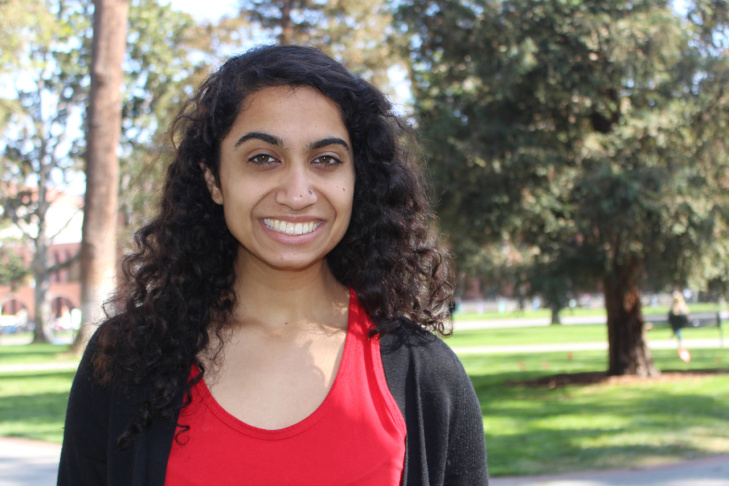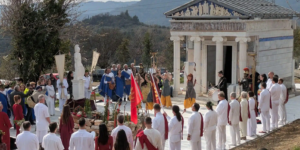On a Wednesday night, Arshya Gurbani reaches into a white cabinet and wakes a couple Hindu gods from their slumber. She carefully lays out statues of Ganesh and Shiva on a table in preparation for aarti, a worship ritual that reminds Hindus to stay humble and give thanks for good fortune.
But Gurbani, 21, and the other members of the Hindu Student Organization at USC put their own modern spin on this ancient practice during their weekly meetings. They play the devotional song “Om Jai Jagdish Hare” on YouTube as they sing off computer printouts. And coupled with the Hindi songs are verses in Sanskrit, spelled out phonetically so anyone can follow along.
“Growing up, you don’t necessarily know what you’re saying, but you keep saying certain Sanskrit phrases anyways,” Gurbani says. “Now that I’m older, I want to know what it means, and that causes me to look at it more critically than I would have if it were in English or even in Hindi.”
Hinduism’s canon of sacred texts — such as the epic poem “Mahabharata” and, within it, the Bhagavad Gita — is written in Sanskrit, but few Hindus today can read or speak the language. Many Hindu-Americans’ religious experiences are taught orally by family members or through translations into modern Indian languages. India’s most recent census numbers reported fewer than 15,000 people identified Sanskrit as their native tongue.
But despite being the world’s oldest language, Sanskrit has survived and remained largely unchanged due to its preservation within religious and scholarly studies. And now a resurgence of interest among young Hindus is pushing this once deemed “dead language” back into the conversation of what it means to be Hindu.
Gurbani and fellow HSO member Pavitra Krishnamani grew up memorizing mantras in Sanskrit, like the Gayatri Mantra, which asks for inner power, even though they didn’t always know what they were saying.
Krishnamani, 20, and her family speak Tamil, a Dravidian language used in south India that doesn’t derive from Sanskrit. To her, Sanskrit is more than just another language of communication.
“I may not necessarily always know what the words mean, but they have a certain feel to them when I say them,” Krishnamani says. “Being able to say those chants, I wouldn’t call it a vital part of Hinduism, but it’s a vital part of my experience.”
“Those chants carry an energy with them, that people have been reciting them for millennia with the same spiritual thoughts in mind,” adds Swami Atmavidyananda, the faculty advisor to the religious group.
Many Hindus share Krishnamani’s and Atmavidyananda’s religious experience with the language, says David Buchta, who teaches Sanskrit at Brown University.
“Many people have this idea that it’s one thing to know what the teachings of the ‘Mahabharata’ itself are, but the language is another thing, that even the language of the Bhagavad Gita is somehow, just by itself, sacred,” Buchta says. “There’s this idea that just hearing the language itself has some kind of spiritual restorative power to it.”
But also underlying Sanskrit is its power to unite Hindus under one religious umbrella. Sanskrit is rarely used in everyday conversation, but it gives Hindus a sense of commonality, especially in a religion whose rituals can vary from household to household and whose language of worship changes from region to region.
India has 22 official languages recognized by the government, according to census numbers, but there are hundreds of other languages and dialects spoken throughout its population.
“In India, we have close to 300 to 400 languages, but all of them are connected to this one thing, this mother language,” says Swami Ishwarananda, who heads the Los Angeles branch of Chinmaya Mission, which boasts 300 centers worldwide.
Ishwarananda teaches Sanskrit classes at the Mission but dismisses the idea that knowing Sanskrit gives some Hindus a spiritual advantage. Instead, like learning any language, he says Sanskrit provides a lens into a cultural heritage that can lead to a stronger foundation of faith.
Gurbani, who only speaks conversational Hindi, says she doesn’t see knowing Sanskrit as a requirement to be a Hindu.
“There might be certain words that carry different meanings in different languages, but in terms of religious teachings, the concepts should be universal enough that are explicable in any language,” Gurbani says, tucking Ganesh and Shiva back into their sleeping chambers.
Still, she hopes to one day learn the language to better understand the mantras she chants.
“It’s important for us to keep Sanskrit as part of our religion,” Gurbani says. “When everyone chants together, it keeps up that tradition.”
































